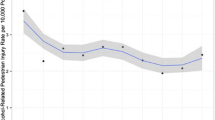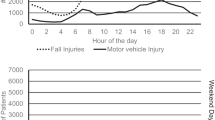Abstract
This study conducted a geostatistical analysis of ecological data to examine the relationships of neighborhood characteristics, including alcohol availability and alcohol consumption patterns to pedestrian injury collisions. The central research question asked whether it was possible to identify unique neighborhood characteristics related to alcohol- and non–alcohol-involved pedestrian injuries. It was hypothesized that greater numbers of alcohol-involved pedestrian injuries would be observed in areas with greater concentrations of alcohol outlets, even after adjusting for socioeconomic characteristics, environmental factors, and drinking patterns of neighborhood residents. It was also hypothesized that independent of drinking patterns and alcohol availability, greater numbers of pedestrian injuries would be observed in areas with higher unemployment, lesser income, greater population, and a predominance of younger or older age populations. Archival and individual-level data from a general population telephone survey were obtained from four California communities. The survey data included sociodemographic and drinking pattern measures. Archival data included environmental measures relevant to pedestrian travel and measures of alcohol availability. Units of analysis were geographic areas within each community defined by the spatial clustering of telephone survey respondents. The results showed that alcohol-involved pedestrian collisions occurred more often in areas with greater bar densities and greater population, and where the local population reported drinking more alcohol per drinking occasion. Pedestrian collisions not involving alcohol occurred more often in lower income areas with greater population and cross-street densities, and in areas having either younger or older age populations. The identification of neighborhood variables associated with pedestrian collisions has important implications for policy formation and targeted prevention efforts.
Similar content being viewed by others
REFERENCES
Calhoun, A.D., McGwin, G., King, W. D., & Rousculp, M. D. (1998). Pediatric pedestrian injuries:Acommunity assessment using a hospital surveillance system. Academic Emergency Medicine, 5(7), 685–690.
Gruenewald, P. J., & Nephew, T. (1994). Drinking in California: Theoretical and empirical analyses of alcohol consumption patterns. Addiction, 89, 707–723.
Gruenewald, P. J., Millar, A. B., Treno, A. J., Yang, Z., Ponicki, W. R., & Roeper, P. (1996). The geography of availability and driving after drinking. Addiction, 91, 967–983.
Gruenewald, P. J., Stockwell, T., Beel, A., & Dyskin, E. V. (1999). Beverage sales and drinking and driving: The role of onpremise drinking places. Journal of Studies on Alcohol, 60, 47–53.
Heeren, T., Smith, R., Morelock, S., & Hingson, R. (1985). Surrogate measures of alcohol involvement in fatal crashes: Are conventional indicators adequate? Journal of Safety Research, 16, 127–134.
Holder, H. D., Gruenewald, P. J., Treno, A. J., Ponicki, J.W., Grube, R.G., Saltz, R. B., Voas, R. B., Reynolds, R., Davis, J., Sanchez, L., Gaumont, G., & Roeper, P. (2000). Effect of communitybased interventions on high-risk drinking and alcohol-related injuries. JAMA, 284, 2341–2347.
Holubowycz, O. T. (1995). Age, sex, and blood alcohol concentration of killed and injured pedestrians. Accident Analysis and Prevention, 27, 417–422.
Honkanen, R., Ertana, L., Kuosmaned, P., Linnoila, M., & Visuri, T. (1976). A case-control study on alcohol as a risk factor in pedestrian accident: A preliminary report. Modern Problems in Pharmacopsychiatry, 11, 46–50.
Insurance Institute for Highway Safety. (1997). Facts 1996 fatalities: Pedestrians. Arlington, VA: Insurance Institute for Highway Safety.
LaScala, E. A., Gerber, D., & Gruenewald, P. J. (2000). Demographic and environmental correlates of pedestrian injury collisions: A spatial analysis. Accident Analysis and Prevention, 32, 651–658.
Lemmons, P. H. H. M., & Knibbe, R. A. (1993). Seasonal variation in survey and sales estimates of alcohol consumption. Journal of Studies on Alcohol, 54, 157–163.
MapInfo. (1997). MapInfo for Windows 4.5: Reference manual. Troy, NY: MapInfo Corporation.
Miles-Doan, R. (1996). Alcohol use among pedestrians and the odds of surviving an injury: Evidence from Florida law enforcement data. Accident Analysis and Prevention, 28, 23–32.
Mounce, N., Pendleton, O., & Gonzales, O. (1988). Alcohol involvement in Texas driver fatalities. Texas: Texas Transportation Institute, Texas A & M University, College Station.
National Highway Traffic Safety Administration. (1997a). Traffic safety facts, 1997:Pedestrians.Washington, DC: National Highway Traffic Safety Administration.
National Highway Traffic Safety Administration. (1997b). Traffic safety facts, 1997: Alcohol. Washington, DC: National Highway Traffic Safety Administration.
National Highway Traffic Safety Administration. (1997c). Traffic safety facts, 1997: Older population. Washington, DC: National Highway Traffic Safety Administration.
Oxley, J., Fildes, B., Ihsen, E., Charlton, J., & Day, R. (1997). Differences in traffic judgments between young and old adult pedestrians. Accident Analysis and Prevention, 29, 839–847.
Ponicki, W. R., & Gruenewald, P. J. (1998). S 3: Spatial statistical system user's guide, V3.2. Berkeley, CA: Prevention Research Center.
Richman, A. (1985). Human risk factors in alcohol-related crashes. Journal of Studies on Alcohol, 10(Suppl. 10), 21–31.
Roberts, I., Norton, R., Jackson, R., Dunn, R., & Hassal, I. (1995). Effect of environmental factors on risk of injury of child pedestrians by motor vehicles: A case control study. British Medical Journal, 310, 91–94.
Scribner, R. A., MacKinnon, D. P., & Dwyer, J. H. (1994). Alcohol outlet density and motor vehicle crashes in Los Angeles County cities. Journal of Studies on Alcohol, 55, 447–453.
Stevenson, M. R., Jamrozik, K. D., & Spittle, J. (1995). A casecontrol study of traffic risk factors and child pedestrian injury. International Journal of Epidemiology, 24, 957–964.
Van Oers, J. A. M., & Garretsen, H. F. L. (1993). The geographic relationship between alcohol use, bars, liquor shops and traffic injuries in Rotterdam. Journal of Studies on Alcohol, 54, 739–744.
Wazana, A., Krueger, P., Raina, P., & Chambers, L. (1997). A review of risk factors for child pedestrian injuries: Are they modifi-able? Injury Prevention, 3, 295–304.
Author information
Authors and Affiliations
Rights and permissions
About this article
Cite this article
LaScala, E.A., Johnson, F.W. & Gruenewald, P.J. Neighborhood Characteristics of Alcohol-Related Pedestrian Injury Collisions: A Geostatistical Analysis. Prev Sci 2, 123–134 (2001). https://doi.org/10.1023/A:1011547831475
Issue Date:
DOI: https://doi.org/10.1023/A:1011547831475




